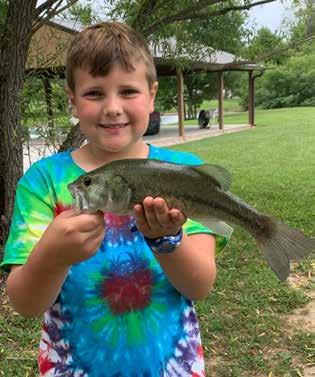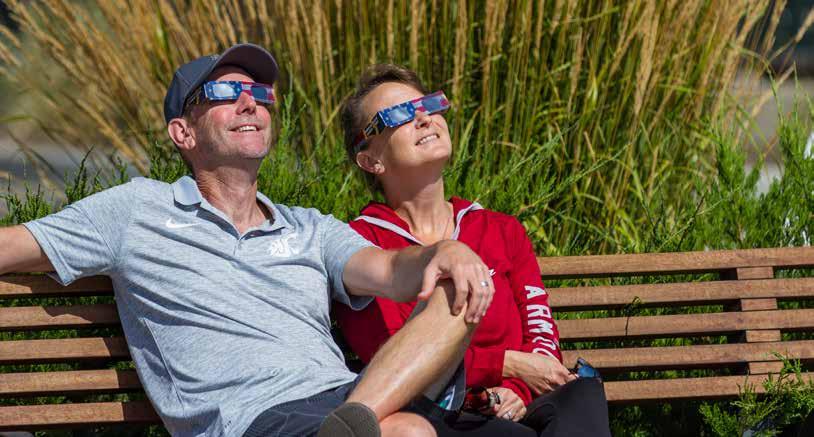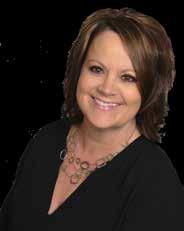












































Jim Godby was born on December 10, 1941, and grew up in a farming family in Sheridan, Indiana. He spent his youth in 4-H, FFA, and athletics. He feels these activities taught him commitment, self-confidence, leadership and determination. These valuable tools would be the foundation later used to serve his country and start a successful business.
Jim studied agriculture at Purdue University. He graduated with distinction while completing the ROTC program. He then served his country in Vietnam.
Coming home from the service, Jim began a career in agriculture until a friend in the furniture business offered him a job, which he accepted. After about three years he thought that it was time to try it himself. He moved the family to his hometown of Sheridan in 1974, and a family member co-signed a $5,000 loan so he could start his new venture.
On September 1, 1974, Jim opened a 600-square-foot showroom in Sheridan. He displayed four sofas, a few recliners, a bedroom suite and a mattress set. When something sold, he went to a wholesale
furniture warehouse in Indianapolis and bought its replacement. He took help from friends and family whenever he could. It’s not uncommon for customers to tell the staff how they purchased their first piece of furniture at the Sheridan location.
Jim was content with the status of the company when his son, Jeff, approached him about joining the company. Jeff saw the potential to grow the business to multiple locations. Jim wrote a letter trying to dissuade him, but in the end they agreed to give it a try.
Jeff began working with his father in 1992. In that time they succeeded in their goal of adding stores and increasing visibility through more advertising. They quickly decided to open a store in Lebanon. Three years later they recognized that the west side of the city was the perfect place to grow. After considering locations in Brownsburg, Danville and Plainfield, they found a piece of land off Rockville Road in Avon. In 1997 they built a 30,000-square-foot building. The store proved to be a great success and 10,000 more square feet were added in 2003.
Jeff is now the second-generation owner of Godby Home Furnishings. Jim has retired, although he’s still very much a part of the business. “My dad’s not wired to sit around,” says Jeff. “He’s officially retired, but he still does what he calls the fun stuff, like mowing the yard at the warehouse and trimming the bushes. He’s also still a mentor to everyone because his work ethic is unmatched. He doesn’t know anything besides working, which garners a lot of respect from our employees.”
The team at Godby Home Furnishings takes great care in providing a comfortable work environment. “It’s amazing when I go down the roster and see how long many of our staff have been with us,” says Jeff.
Finding the right manager for the Avon store was an easy choice. Gregg Fennell had retail experience and was a graduate of Sheridan High School. He and Jeff played baseball together there. After a few moves, Fennell is back leading the team in the Avon store where he started in 1997. In fact, many of the employees that began their Godby careers when that store opened are still there today.
Godby Home Furnishings employs around 100 people, the vast majority of whom have been there for a decade or more. The current staff has over 800 years of combined service to the company. They enjoy great benefits including an unrivaled 401(k) program and a yearly Christmas party, with bonuses based on years served with the company. Most of them describe co-workers as a big family.
Their loyal customers come back, time and again, not just for the superior service, but also because of the high-quality product.
“That’s in our company motto: ‘Quality furnishings at affordable prices,’” says Jeff, noting that their starting price points are incredibly attractive. Plus, they treat all customers the same and never play games when it comes to cost. They are not about negotiating deals with customers. Everyone who walks in gets their best sale price.
The motto has been the foundation since opening in 1974. Fifty years later, there are locations in Avon, Noblesville/Fishers, Carmel, and a clearance store in downtown Noblesville. They’ve become one of the largest furniture companies in the Midwest, verging on becoming one of the top 100 stores in the nation.
The stores are constantly refreshed with new product. Their aim is to help their customers create their dream home at any budget. From the furniture to the accessories, down to area rugs, they take pride in providing everything needed. All of their sales associates have extensive mattress training because a great night’s sleep is the key to the comfort and well-being of their clientele.
Having their own 75,000-square-foot distribution center in Westfield allows them to stock most everything you see on their sales floor. You can have your new furniture delivered in a matter of days by their own team of drivers, or pick it up yourself on the same day.




Godby Home Furnishings is involved in philanthropic efforts to help the community, especially for causes that are important to their employees, such as Little League, church outreaches, or charities that employees are passionate about. They also are big sponsors for local programs like the Sheridan Youth Assistance Program.
“We had success in those early days because lots of friends and relatives came to that first store in Sheridan to make the whole thing happen,” says Jeff. “They wanted to see a local kid in the community make good.”
And that he did, in so many ways.
Happy 50th Anniversary, Godby Home Furnishings!
Godby Home Furnishings
is open seven days a week and is located at 8171 Weston Avenue in Avon. For more information, call 317-242-4581 or visit godbyhomefurnishings.com.







Writer / Matt Keating Photography Provided

Katja Kimball, president of Paws, Wings & Other Things, has a special place in her heart for wild animals, and goes out of her way to help them.
She says the mission of Paws, Wings & Other Things is “to rescue and rehabilitate orphaned, injured or sick native Indiana wildlife and return them back into their natural habitat, as well as educate the public about wildlife and promote their conservation.”
It’s a mission that requires a lot of time and dedication. Kimball often works 17 hours a day to help wild animals. She is fully committed to helping creatures in need.
“I am state and federally licensed to rehabilitate mammals and birds,” Kimball
says. “The public can reach out to me for injured and orphaned wildlife, and I take in the animals to provide the care they need. When they are ready, we return them to the wild.”
Kimball gets medical help for the animals when they need it.
“I have a licensed veterinarian that comes to my facility to ensure the proper care for the animals,” Kimball says.
Kimball also educates the community on how they can help wild animals.
“I give educational talks when groups or places reach out,” Kimball says. “These talks are free.”
Kimball has rescued and rehabilitated

some very sick animals recently, including raccoons, foxes and owls.
“We received several foxes with mange, which is caused usually by stress, because these foxes have a lowered immune system and have underlying infections,” Kimball says. “They get treatment for mange and antibiotics. We get many


raccoons throughout the year. The most recent ones had injured feet and legs. One was hit by a car and had internal injuries. We currently have four barred owls in our care. They were hit by cars or got caught on a fence or had eye injuries.”
Kimball says Paws, Wings & Other Things always needs financial help.

“People can mainly help with donations and ordering from my Wish List on Amazon,” she says. “We need money, old towels and blankets, toys, stuffed animals, and meat donations. We currently have meat eaters. To raise money, we also have Facebook fundraisers. We need money for vaccines and formulas. The donations we get really do make a huge difference.”





Kimball plans to stay dedicated to Paws, Wings & Other Things for many years to come. She says she has been dedicated to helping animals since she was younger.
“I’m from Germany,” she says. “I started caring about animals as a child. I moved to the United States in 1989. I was one of the founding members of Paws, Wings & Other Things. The name was my idea. I’ve been with the organization for almost 10 years. I took over the 501(c)(3) in 2019, and now run it with my husband and two assistants.”
Kimball often works late into the night helping the animals.

“My life revolves around wild animals,” she says. “I have four vacation days in the summer. This life is not for everyone. The animals can scratch because they are scared. It takes a lot of knowledge to take care of them. If people want to help the wild animals here, financial donations are the best way to help. We have had people with great intentions reach out to us wanting to help, but this isn’t a cute place where you take care of little puppies and kittens. The wild animals don’t want to play. They are scared, hungry and hurt. We work with animals with claws and beaks. You must be able to read their body language and know when they want to be fed, or when to clean out their cages. We do appreciate the positive support we get from people though. It means so much.”

Kimball says working at Paws, Wings & Other Things is worth it because she helps numerous animals each year.
“We rehabilitate around 1,000 animals a year and we are very grateful for the support we have received from our followers,” she says. “We couldn’t rescue this many animals without their support.”
For more information on Paws, Wings & Other Things, call 317-263-1131 or email katze593@yahoo.com. Also visit them on Facebook @pawswingsandotherthings.




Colorectal cancer is no match against Franciscan Health’s nationally accredited cancer programs, board-certified oncologists and dedicated fellowship-trained colorectal surgeons. Our multidisciplinary team works around the clock to offer prompt diagnoses, advanced treatment options and the latest clinical trials to fight and beat colorectal cancer.
Schedule an Appointment OR Second Opinion today!
FranciscanHealth.org/ColonCancerCare

The Hendricks County 4-H Fairgrounds is preparing to welcome more than 150 youths to the Indiana Junior Rodeo Association (IJRA) and National Little Britches Association event this spring.
“The IJRA has been around for 35 years, and in 2018 we moved to the Hendricks County 4-H Fairgrounds as our permanent facility,” said Andreah Caldwell, treasurer for the IJRA. “When we moved there we had about 60 kids participating, and today our rodeos host between 130 and 180 kids. They’re coming from all over the state and surrounding areas, and we’re really excited to have this centrally located facility.”
Children as young as 4 years old can get their start at the rodeo competition with categories like dummy roping, barrels, goat untie and others.

As they practice and learn more, their skill levels increase, and the difficulty does too.
Ages 5 to 8 add goat tie and calf riding to their repertoire. There’s a junior division for girls aged 9 through 13, and another for boys. The oldest in the junior rodeo are separate girl and boy divisions, aged 14 to 18, and they move into bull riding, saddle
bronc riding and team roping, to name a few.
“The ratio is about 60% girls at the moment,” Andreah said. “That’s because there are a ton of barrel racers throughout all age groups, but when you get into calf ropers, for instance, there might be only eight of them.”
Start a conversation with a provider today

Aaron ‘Gabe’ Woodruff, NP Family Medicine
Do you have health questions or symptoms that have been weighing on your mind? Gabe Woodruff, NP, with St. Vincent, has returned to his hometown of Brownsburg and has new patient appointments available. Start a conversation with him about checkups, screenings, new symptoms or chronic conditions, today.

Breakaway roping has become more popular over the years, just recently added in Professional Rodeo Cowboys Association events, and soon the National Finals Rodeo events.
Primarily a women’s competition, breakaway roping involves riding horseback while roping a calf. The rope breaks away from the saddle once the calf gets far enough away from the horse.
As more events like this are accepted in the professional arena, the more opportunities young people have to compete in the future. That’s important to women like Kennedy Hayes, who participated in her first rodeo in preschool.
“I compete in senior girls breakaway roping, barrel racing, goat tying and pole bending,” Hayes said. “I’d say I practice breakaway the most. Throughout the summer I spend four to five hours a day practicing and exercising my horses. During the school year it’s probably two to three hours a night.”
While sitting in the audience and watching participants ride a wild horse or bull, the

For those in the arena, it may be a lot of work but it’s also a lot of fun.
“I think every little boy or girl dreams of being a cowboy,” Andreah said. “We’ve all watched the westerns. It’s something we want to be a part of and it’s kind of fascinating.”
Creek Caldwell, Andreah’s son, has been participating for 12 years.
“It’s just what I love to do,” Creek said. “I like saddle bronc riding. You come out on a horse that’s not broke. It’s just like riding a bull. You have to stay on for eight seconds. There’s also a lot of scholarships available and I’ve been getting calls from colleges with rodeo programs.”
amount of work the young people put in might not be evident, but it’s an entirely different lifestyle from those who are not involved.
“It’s a family-oriented association,” Andreah said. “We call it our rodeo family because we’re sleeping in campers next to each other two weekends out of the month sometimes. It allows us to be very close and connected. These kids are often matured beyond their years. They are around adults all the time. My kids’ best friends are at the rodeo and I think many of them can say that.”
In addition to the practice and the friendships, the lessons learned truly develop the youth in a unique way. They learn independence, commitment, hard work and discipline.
“If you don’t put in the hard work, the outcome won’t be what you want,” Hayes said. “I think there’s a toughness that you learn. When it’s negative 5 degrees this winter, you still have to go out and feed your horses. Every day you’re going to feed, clean the barn and put in your practice time.”
The IJRA is a nonprofit and depends solely on sponsorships to help pay for award packages. In addition, participants solicit a minimum of $100 to be eligible for the awards.
“Last year we were able to provide about $30,000 in prize money, and another $30,000 in awards like saddles, buckles and tack,” Andreah said. “We depend on our

sponsors for all of that.”
Not only does the program move youth to participate in public speaking while sharing their passion with others, but it also fosters leadership skills.
“We have a student board,” Andreah said. “They help plan activities for the younger kids. It takes a lot of hard work and determination to be successful.”
Hayes said she too is looking at colleges with rodeo programs.
Both teens have obtained their ProRodeo card, allowing them to compete at other competitions against adults with more experience.
“I think it’s the adrenaline and the excitement, but it’s also seeing the outcome of the hard work I’ve put in,” Hayes said. “You see all the little kids looking up to you and that makes it worth it. You’re looking up to your own people - your parents, other
competitors with more experience - and the younger ones are looking up to you.”
Like many other sports, there is a level of danger and risk of injury, but with practice and experience, the risk decreases.
“There are concerns,” Andreah said. “We have many rodeos where no one gets hurt, but on occasion there’s a broken arm. I feel like it’s similar to football or baseball.”
Also similar to other sports, the love of rodeo is often passed down from generation to generation. Parents who rodeoed professionally have led their young ones to get their start.
It’s an atmosphere and bonding experience many of the youth appreciate.
“My dad was into rodeo and he and I practice together, and my mom is very



involved,” Hayes said. “She’s into the health and nutrition part. She makes sure the horses are healthy. There’s a lot of family time when you’re traveling all summer long; you’re in the truck for hours at a time together.”
The IJRA season begins in August each year, with rodeo competitions nearly every month throughout the school year. Many of those competitions, including the annual awards banquet, are held at the Hendricks County 4-H Fairgrounds.
“The partnership we have with the Hendricks County Fairgrounds and the awesome facilities they offer is a part of our growth and success,” Andreah said. “We’re really grateful to [Executive Director] Steve Patterson and the staff. They’ve been awesome to work with.”
For more information on the IJRA, visit indianajuniorrodeoassociation.org.







WILL SEXTON IS ENJOYING HIS ROLE AT IU HEALTH WEST AMID AN IMPRESSIVE MILITARY CAREER
Writer / Charlotte Stefanski
Photography Provided
Will Sexton has always been drawn to the human body - how it works and the science behind it.
“Sports and human movement were always interesting to me,” he said. “It just made sense to me.”
When he enrolled at Indiana University he studied kinesiology, the science of movement, and exercise science for his undergraduate degree, then pursued his master’s degree in exercise physiology.
But those weren’t his only interests. Sexton had always wanted to enlist in the military.
“I had always wanted to but my mother was always afraid of it, so she tried to talk me out of it,” Sexton explained. “But I still had that itch.”
He officially joined the United States Army in 2003, and for the next 13 years, 10
months and 25 days (not that he counted), he was on active duty. After that stint, his family of five decided it was time to settle down somewhere. First, Sexton took an assistant director of imaging position at Texas Children’s Hospital. Four years later he moved back to Indiana, and joined Terre Haute Regional Hospital as director of imaging services and special diagnostics. His family lived in Avon because his wife was a teacher in Zionsville, and IU Health West Hospital seemed like the perfect fit for him.
“I was like, ‘I’d love to get an opportunity there,’ and then about a year and a half later it opened up, and I was like, ‘I have to,’” Sexton said. “I felt very fortunate to get that opportunity.”
Sexton officially joined the IU Health West team as director of imaging services in August 2022, but within the span of a few

weeks, active duty would call again, and he was off to Kuwait.
He’s now officially back and working to get reacquainted with the IU Health West team.






Sexton was 29 with a child on the way when he first enlisted in the Army, and while leaping out of planes looked fun, he decided to stay in the medical field to grow and share his expertise.
The Army had a wide array of roles both in and out of health care, and radiology piqued his interest. As someone who had broken bones and had strains, it seemed like the perfect field for Sexton.
His traditional schooling in Indiana was much different from training in the military. He explained that the military streamlines all its medical training, whereas in college, students have plenty of book work, and get a deep understanding and a lot of knowledge from reading.

“In the Army everything is very cut and dry,” he said. “It’s a methodology more than anything. You’re thrown into it and expected to perform, and so your development and your knowledge comes from your experiences, versus learning from a book.”
Luckily for Sexton, he already had in-depth knowledge about the body and bones from schooling. While others had trouble with terms and names, he was on top of it.
His first duty station was in Grafenwöhr, Germany, where he was the only X-ray technologist for his first three years. Eventually the team grew to five and shot about 20 to 25 films per day, which gave him plenty of free time.
Sexton then went on to receive training in nuclear medicine with both the U.S. Navy and Brooke Army Medical Center. He was then stationed at Fort Knox for about 14 months, but then decided to re-enlist, and went back to the Brooke Army Medical Center in Texas to become director of imaging services.
“It finally got to the point where I felt like I’d outgrown my role and there was nowhere to go, unless I was going to do more Army activities - which, at 40 years old, most people retire,” Sexton said.
He shifted gears, going into the Army Reserve. Now he’s a transportation mobility warrant officer, tracking large movements for the Army.
IT’S MY JOB TO MAKE THE TIMELINE FROM THE PORT TO THE FIGHT. THAT’S WHAT I DID IN MY LAST DEPLOYMENT. I TRACKED ALL THE MOVEMENTS IN AND OUT OF KUWAIT, IN AND OUT OF THE MIDDLE EAST.

Sexton officially returned to IU Health West this October, resuming his role as director of imaging. Within that role, he serves as the strategic leader for radiology.
“We’re trying to keep a pulse on what’s happening in the imaging world, as well as what’s happening at IU Health West, melding the two together to look ahead down the road so that we can meet the needs of patients and doctors,” he said.
IU Health West’s imaging team is the only 24/7 imaging department in the IU Health Indianapolis Suburban Region, including IU Health North, Saxony, Tipton and West hospitals. This includes all forms of imaging, like CT, MRI, radiology and ultrasounds.
It’s one of the region’s busiest departments, Sexton said, with a large capacity of two

MRI machines and three CT units.
Sexton is also a bit playfully competitive with other departments in the hospital, and he’s always looking for ways to encourage and improve his department. His natural curiosity also plays into his leadership role.
“Leadership is different every day,” he said.
“You have your standard goals - you want to mentor people, change and lead the way. But every day is a new day. When you walk
in, you have a new set of challenges. There’s always something that’s boiling in the background. That’s exciting to me.”
Now that he’s back, Sexton is getting reintegrated with his role and team, and working to build a better grasp on it.
“Our team is fantastic,” he said. “They do a great job. Our culture is wonderful and that’s a credit to our leadership.”










One East Main Street Brownsburg, IN 317-852-2268
hendrickscountybank.com

Today most major nationwide banks offer wealth advisory services to help their clients grow their money. Even local banks have gotten into this game more recently. For years, Hendricks County Bank and Trust Company has considered starting a wealth advisory division. They were just waiting for the right time and the right people to have in place. Everything came together in November 2023 when they hired Seth Cromer to head up the Wealth Advisors division.
“This is a strategic initiative that fits in well with our mission statement, which says, in part, that we’re here to promote economic prosperity and to improve the quality of life in the Hendricks County community,” says Jerry Orem, president. “Financial services are a natural offshoot to the banking products and services we offer our customers.”
Hendricks County Bank and Trust Company has clients who have been with them their entire life - perhaps 50, 60 or 70 years. As a result, strong relationships have been built over time. Hendricks County Bank has five branches. At each branch, any time a customer walks through the door,
they’re greeted, and more often than not by name. You don’t get that personal touch at many bigger banks.
“People would rather not go outside of the community they like and know for advice on what to do with their retirement savings,” says Cromer, a lifelong resident of Hendricks County.
While many larger entities might only be interested in working with individuals with a high net worth, at Hendricks County Bank, they offer the same products and services to customers with a high net worth and those with modest means.
“We work with people who maybe have a job change and a 401(k) to rollover, or perhaps they’re self-employed and need to start an IRA,” Orem says. “That’s the niche we fill that the larger brokerage houses probably overlook.”
Cromer, who over the next few years will be building out and growing Hendricks County Wealth Advisors, loves the diverse tapestry of his days. For instance, he
recently started out his day talking to a small-business owner who wanted to set up simple IRAs for his handful of employees. Cromer shared details on the new tax benefits and tax breaks for small-business owners who start such a plan. From there, he met a college student who was looking to set up an IRA for the internship he just completed, as well as his upcoming summer internship. Finally, he made a house call to an 80-year-old customer who didn’t want to go out in the bitter cold. “It benefits me as well; I always get good tea and coffee when I go to her house,” Cromer says with a smile.
The day demonstrates the full spectrum of the clientele Cromer works with, which exemplifies the purpose of a community bank.
“All of these clients are in completely different stages of life and different stages in their financial situations,” says Cromer, who enjoys learning about his clients’ interests and hobbies. “Relationship building is the best part of this process, as we focus on these differences and work together to develop a plan that best serves each situation.”

On April 23, 2022, Brian and Crystal Clark suffered a parent’s worst fear.
Their two children, Xander, 9, and Ziva, 8, were killed instantly in a freak accident no one could have seen coming.
“We were at our campground on a beautiful spring day,” Crystal said. “It was extremely windy but 70 degrees and the sun was shining. We went for a golf cart ride and found friends at our favorite fishing spot. They were taking turns taking fish off the hooks. Ziva would kiss the fish and throw it back in, and Xander was twirling a worm around his finger just before we left.”
After a short visit, the family of four got back into the golf cart with promises to return soon, but once they were traveling down the path, they heard a loud sound and couldn’t tell which direction it was coming from.
“It sounded like a plane was crashing into the woods,” Crystal said. “A tree came down, hit the F150 to the right of us, and then on top of our golf cart. We were in the front seat, and Xander and Ziva were in the back. The tree missed us by inches but struck the children directly and they were gone.”
Paramedics came, but shortly after, they confirmed what the Clarks already knew.
“This was a 30-foot-tall tree and it split from the trunk about two feet off the ground,” Brian said. “It’s something, as a parent, you wouldn’t ever think of. You can think of a thousand things you need to do to protect your children, but this doesn’t even pop into your mind.”
Despite their shock and pain, the couple set out to warn others about the dangers of damaged, dead and hollow trees.
They hope to save a life by making others aware of what could happen.
“You can’t just look at the tree and know if it’s dead or alive,” Brian said. “It’s not something you can see, but we can pay attention. Have your trees checked regularly by a professional. Most tree companies give free quotes.”
The couple have spoken with other parents who have experienced a similar loss, and though it’s a rare occurrence, they have others thinking.
It’s not uncommon for those who have heard their story to reach out, letting them know they’ve had their trees examined or removed.
The Clarks simply hope people are proactive.
Last spring, billboards in Indianapolis and surrounding areas featured Xander and Ziva, warning the public about the dangers of unmonitored trees.
Brian and Crystal also hang the same banner from their trailer while traveling around the state to various barbecue competitions. The banner is always noticed and always discussed.
“It’s a tragedy we live every day,” Crystal said. “We couldn’t save our own children, but maybe their legacy will save someone else. If we can do something that plants a little seed in someone’s mind, it’s more than what they thought about it before. We don’t want anyone else to feel this unimaginable pain.”




April is Alcohol Awareness Month, a time to raise awareness for alcohol abuse. Many families face difficulties when a loved one struggles with alcohol abuse. Supporting someone through this journey requires empathy, patience, and a multifaceted approach aimed at both the individual and their support system.
Alcohol abuse is a complex issue with multifaceted roots. It impacts not only the individual, but also their relationships, work and overall well-being. Recognizing the signs, which may include increased tolerance, mood swings and neglect of responsibilities, is the first step in addressing the problem.
Initiating open, nonjudgmental conversations can pave the way for support. Express your concerns calmly, emphasizing care and understanding. Listening actively and without interruption fosters trust and encourages your loved one to share their struggles.
Learning about alcohol abuse, its effects, and available treatments equips you to offer informed support. Understand that addiction is a complex disease, often requiring professional intervention.
Gently encourage your loved one to seek professional help. Offer to assist in finding resources, whether it’s counseling, therapy, support groups or an addiction treatment program. Highlighting the benefits of seeking help can alleviate the fear and stigma often associated with treatment.
Setting clear boundaries is crucial for both your well-being and that of your loved one. Enabling behaviors, such as covering up their actions or making excuses for them, can perpetuate the cycle of abuse. Express your support while maintaining boundaries that safeguard your own mental and emotional health.
Supporting someone with alcohol abuse can be emotionally taxing. Engage in self-care activities to recharge and maintain your
own well-being. Seek support from friends, family or professional counselors to navigate your own emotions and challenges.
Recovery from alcohol abuse is a journey with ups and downs. Stay committed to supporting your loved one through this process. Celebrate their milestones and remain a pillar of encouragement during setbacks.
Remind your loved one that recovery is possible. Share stories of individuals who have successfully overcome similar challenges. Instill hope and emphasize that seeking help is a courageous step towards a healthier, fulfilling life.
Remember, while you can offer support, the decision to seek help ultimately rests with your loved one. Encouragement and support are vital, but respecting their autonomy and readiness to change is equally important.



Photography Provided
One of the most controversial topics in the world of pets today swirls around service animals, therapy pets and emotional support pets. As a trainer, I’m frequently asked how to train pets to fill the needs of their owners. Each category has its own requirements. The time it takes to train your pet depends on which job your furry friend has applied for. State and federal regulations are also different for each category.
Service animals, including psychiatric animals, are trained to perform a certain
job. These jobs are as varied as the dogs themselves. Service dogs can be trained to bring things to you, open doors, watch for traffic, alert you if a phone is ringing, or tell you if someone is at the door. Other dogs help with less noticeable illnesses like diabetes, autoimmune disorders and seizures. Psychiatric dogs help people cope with trauma. They alert someone to situations that could result in harm to that person.
Service animals require more training because their jobs are more specialized. It
is also extremely important that the service animal has a strong bond with the person they will be helping. The bond between a human and an animal affects the way the animal responds to the human. It also changes the way the human responds to the animal. The more you do with them, the more they are going to want to be with you, and the easier it will be for them to determine when something is not right. If they don’t spend as much time with you, they may sense something is off, but not alert you as quickly or as effectively as they could. State and federal regulations allow
service animals to accompany their human everywhere.
Therapy pets are not service dogs or emotional support pets. They help people mentally and physically. I break this group into two categories: mental health and physical health. The mental health therapy pet is there to brighten someone’s day. The physical health pet helps people improve their fine motor skills through petting, grooming and playing.
Therapy pets migrate toward places where people are “house bound,” like hospitals and nursing homes. There are very few restrictions regarding the type of animal, but the requirements remain the same. A therapy pet must respond to basic commands: sit, down, come and wait. They must not jump on people or pull on their leash when walking. They are required to pass a temperament test. Your pet must enjoy being around people and crowds. The pet should not get upset if they get bumped, their tail accidentally gets stepped on or their fur gets tugged. State and federal regulations limit where these pets are allowed to go.
Emotional support pets are not service animals or therapy pets. This group of pets offers support to their owners during difficult situations. They do not require any special training, and there are no restrictions on breeds or species. Emotional support pets should have some basic manners - commands like come, sit, lay down and wait, as well as walking on a leash without pulling - and be comfortable in new environments. The number of places where you can take your pet is slowly increasing. Several restaurants now have areas designated for pets. Bookstores, craft stores, hardware stores, home improvement stores and big-box stores are changing their views on pets. State and federal regulations don’t offer guidelines for emotional support animals. Individual business and managers usually decide if these pets are welcome in their establishments.
There are some big differences between these three categories, but the bottom line is our pets make a big difference in our lives and the lives of the people they come in contact with.
Have questions about training your pet? Send me an email at taramarie611@gmail.com and I’ll be happy to help.





When Hendricks County experiences its first total solar eclipse in more than 800 years on April 8, residents should plan to attend one of the many local events countywide to celebrate the astronomical phenomenon.
Hendricks County and central Indiana will be a popular spot for visitors, with the area experiencing darkness for more than three minutes. So, county businesses and organizations have already begun plans to host watch parties and even day-long festivals to celebrate and receive the proper eyewear to view the eclipse.
With local schools closed that day and many visitors expected to come here, town, county and state police agencies say they are ready.
“The eclipse has been a discussion for me, emergency management and the chiefs of police here in Hendricks County for some time now,” said Hendricks County Sheriff Jack Sadler. “We have all been in communications with the Hendricks County Communications Center and are prepared for the influx of people.”
All major law enforcement agencies within the county, including the Sheriff’s Department, are increasing staffing levels
to accommodate the potential need for the eclipse. In addition, the Indiana Department of Homeland Security will activate and staff the State Emergency Operations Center that day to help coordinate at the state level.
Officials have estimated around 100,000 people will travel to central Indiana to see the eclipse, with up to 500,000 estimated statewide. With central Indiana experiencing 100% totality, and so many towns and counties in addition to Hendricks County holding public events, the number of visitors will be spread out, alleviating any kind of pressure in one specific area.
• The Indianapolis 500 draws about 250,000 to 300,000 people to its one-day event at the Indianapolis Motor Speedway.
• Here in Hendricks County, U.S. Nationals held over Labor Day Weekend handles 60,000 people a day and 150,000 over the course of the weekend.
With preparations already in place, and given our experience in handling crowds, residents should not hesitate to attend any of the planned festivities.
“We are so excited to be in the path of
totality, giving both residents and visitors an opportunity to experience this oncein-a-lifetime event here in Hendricks County,” said Jaime Bohler Smith, Visit Hendricks County’s executive director and chief executive officer. “With so many fun events being planned, we highly encourage everyone to arrive early, enjoy the day and be patient on your return trip home.”
Events and viewing parties both big and small will give residents and visitors plenty of options. Visit Hendricks County even awarded grants earlier this year to help five local businesses host celebrations, including ticketed events at Beasley’s Orchard and Hendricks Live! Two of the bigger free public events include the Race to the Eclipse at Lucas Oil Indianapolis Raceway Park and a military tribute at The Shops at Perry Crossing.
Hendricks County hotel rooms are selling fast but are still available. Affordable camping spots also remain at the Hendricks County 4-H Fairgrounds, Lucas Oil Indianapolis Raceway Park and Raceview Family Campground next to the track.
For more details about the eclipse, all the local celebrations and so much more, go to visithendrickscounty.com/eclipse.
Writer / Josh Duke Photography Provided




Doug and Michelle Moon of Avon’s Wild Birds Unlimited will celebrate 22 years in business this year, and continue to spark interest in the community for those who love wildlife - a dream come true for the couple.
“Michelle and I were both in the medical field,” Doug said. “We worked in the lab, testing in microbiology, hematology and other things, but I grew tired of it. I’ve always dreamed of owning my own business and we both have a love of nature. We thought it’d be cool to have both - our own business that helped nature.”
The couple had visited Wild Birds in Indianapolis, and as luck would have it, they learned Jim and Nancy Carpenter, founders of the franchise, were interested in a location on the west side.
The Moons were the perfect match.
“There were only two or three locations at the time, but today there are over 350 stores nationwide and in Canada,” Doug said.
The store has just what you’d think - bird food, feeders, nesting boxes and baths - and other items that might surprise you.
In addition to a friendly staff and a mutual love for nature, they also offer wind chimes, garden-related items, nature-related gifts, and even jewelry called Fahlo bracelets, allowing customers to follow the movement of an endangered species online.

Bird feeding or watching has become a popular hobby in recent years.
“We were one of the few businesses that thrived during the pandemic,” Doug said. “Everyone was at home and decided to make their backyard a haven. In fact, gardening is the most popular hobby in the United Staes, and bird feeding is second.”
As the weather improves and we’re headed outside, enjoying the sunshine, a beautiful bird might catch your eye, or you may simply be interested in learning more about the animals residing in your backyard.
The Moons said the habitat determines which types of birds you’ll encounter.
“If you live in a wooded area, you’re likely to see woodpeckers, chickadees and cardinals,” Doug said. “If you live in an open area with few trees, you may have goldfinches, bluebirds and swallows.”
Geography plays a part as well.
“When you get up to the dunes in Indiana or further north like the Great Lakes, it’s a whole different ball game than what you’d see here,” Michelle said. “There are even different types of species, like a jay in the Midwest is different than a jay in Texas or California, for example.”


The Moons said everything in nature is connected in one way or another, and natural pollinators can play a role in the health of your property.
“A healthy yard is chemical free and there are plenty of bugs available for the birds,” Michelle said. “Birds can be an indicator of how healthy your environment is. If you’re using a ton of pesticides or the property is void of natural shrubs and trees, you’re less likely to see a healthy population of different birds.”








So how do you get started?
The birds are already present, though we might not see them as often if we’re not paying attention. Doug said feeding them is for our own viewing pleasure. Otherwise, nature will take its course and the birds will find what they need.
Simply start with a basic bird feeder, hang it in the backyard and wait.
“Instead of loose bird seed, we have seed cylinders that the birds just go crazy over,” Doug said. “There are also stackables, which provide a variety of different food. You can hang that from a tree or a shepherd’s pole, and once the birds find it, that’s how you get started.”
From there, a particular bird piques your interest or you can begin experimenting with target feeding for a specific species.
“From year to year, we often see an influx of a particular bird,” Michelle said. “In 2020 people discovered the oriole and those particular feeders flew out the door,” Michelle said. “Orioles aren’t here all the time, so when people began noticing them, they could use specialized feeders or food that might draw them to your backyard for a longer period. It was a really interesting time for people as we learned about the oriole’s behavior.”
Once hooked on the relaxing hobby, many are interested in taking things to the next level. You can create a natural space for wildlife in your own backyard or even become certified through the National Wildlife Federation.

“You can get your backyard certified as a haven for birds and other wildlife,” Michelle said. “We’ve seen entire communities, schools and neighborhoods join together and get certified as a group.”
The entire Wild Birds franchise partners with the Arbor Day Foundation. They also
feeding,” Doug said. “We consider our customers family and it’s just a joy.”
They also help solve problems for avid bird feeders. Perhaps squirrels are getting into the food, or a bird is striking a window at your residence.

“It’s a devastating thing that happens on a regular basis,” Doug said. “The birds see the reflection in the window and they think it’s open. They can kill themselves by striking the window, but there are solutions to that. You can put up decals and other things to prevent that reflection.”






When the customer returns and shares their positive results on an issue now resolved, the owners know they are meeting their goals of nurturing nature and helping others.
They’ve created a family of nature enthusiasts, both in the store and with guests who come in each day.
“We have an incredible, knowledgeable staff that have also developed relationships with our customers,” Michelle said. “Even if Doug isn’t there every day, we’re confident that our customers are being well cared for, and that’s wonderful.”
Up next for the Moons - plenty of possibilities.
“We’ve been talking about it for the past several years,” Doug said. “We’d like to open a second location in the future.”
With the right people in the store, the couple can continue to grow and will
continue attending garden shows like the one at the Hendricks County 4-H Fairgrounds this spring.
They’ll also hold native plant sales, which help customers grow their habitats by offering plants you might not find at local nurseries.
















 DARREN BOSTON
DARREN BOSTON



Three reasons why a mammogram is an important part of your preventive health
1 A mammogram can save your life. Early detection of breast cancer can increase a woman’s ve-year survival rate to 97%.

2 It doesn’t take much time. Mammograms are a quick procedure, only taking about 20 minutes.
3 Your risk of developing breast cancer increases as you age. The older you get, the more you are at risk of developing breast cancer. That’s why mammograms aren’t a one-and-done test.



Mammograms are vital to your health and longevity as a woman. Indiana University Health recommends routine screening mammography to improve the likelihood of detecting breast cancer early. If you have speci c questions about your level of risk for breast cancer, schedule an appointment with your primary care provider.